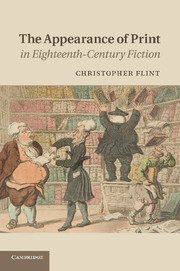Book contents
- Frontmatter
- Contents
- Figures
- Acknowledgments
- Introduction: Prose Fiction and Print Culture in Eighteenth-Century Britain
- Part One Author book reader
- Chapter 1 Pre-scripts: the contexts of literary production
- Chapter 2 Post scripts: the fate of the page in Charles Gildon’s epistolary fiction
- Part Two Reader book author
- Notes
- Bibliography
- Index
Chapter 1 - Pre-scripts: the contexts of literary production
from Part One - Author book reader
Published online by Cambridge University Press: 07 September 2011
- Frontmatter
- Contents
- Figures
- Acknowledgments
- Introduction: Prose Fiction and Print Culture in Eighteenth-Century Britain
- Part One Author book reader
- Chapter 1 Pre-scripts: the contexts of literary production
- Chapter 2 Post scripts: the fate of the page in Charles Gildon’s epistolary fiction
- Part Two Reader book author
- Notes
- Bibliography
- Index
Summary
Books
Horses and asses, flies and devils do
Their labour in the printing art bestow;
No wonder, thence such loads of lumber rise
Dulness and maggots, calumny and lies.
(“On Printing,” prize epigram in The Gentleman’s Magazine, 1735)
Like most other published work in eighteenth-century Britain, prose fiction had to compete actively for a sustaining audience within what was considered a saturated print marketplace, “loads of lumber,” as the prize epigram above puts it. As distinct from printed sermons, for example, fiction went through sporadic periods of popularity until the 1790s, after which it achieved a secure presence in the print marketplace (to the point that many people now regard “literature” primarily as “novels”). The recurring claim that fiction dominated the leisured reading of the eighteenth-century middle classes (and women in particular) should be adjusted, in other words, to accommodate the fact that it was part of a rapid but volatile niche business rather than a hegemonic force in the print market. According to Michael Suarez, “literature, as traditionally conceived, constitutes a relatively small percentage of the books printed in the eighteenth century. In 1753, for example, literary works in English from all genres comprised about 11 percent of all surviving published titles” (150). More specifically, the share of “novels” in the total print output of England probably never reached more than 4 percent, likely less in Wales, Scotland, Ireland, or America. The “rise of the novel,” then, should be properly calibrated to the overall production of books, which was equally exponential, as evidenced by Lee Erickson’s estimate of an increase from 1,800 to 3,000 articles of all genres between 1740 and 1780, followed by a spike in 1792 to 6,000 items (7).
Yet despite its relatively modest and inconstant contribution, many commentators denounced fiction’s influence, from Mary Astell’s 1694 lament in A Serious Proposal to the Ladies that “since the French Tongue is understood by most Ladies, methinks they may much better improve it by the study of Philosophy (as I hear the French Ladies do) Des Cartes, Malebranche, and others, than by reading idle Novels and Romances” (86–7) to the more strenuous accusation by William Davy in A System of Divinity (1795–1807) that the “wretched Trash of Plays, Novels, and Romances with which the World is overrun, hath done infinite Mischief to the Morals of young People. It hath corrupted the Principles, enflamed the Imagination, and vitiated the Taste of thousands” (xviii, 322). In “On Novel Reading” Vicesimus Knox concluded, “If it be true, that the present age is more corrupt than the preceeding, the great multiplication of Novels has probably contributed to its degeneracy” (i, 68). Hannah More laments in “On the Effects of Influence” (1799), “Novels, which used to be dangerous in one respect, are now become mischievous in a thousand. They are continually shifting their ground and enlarging their sphere, and are daily becoming vehicles of wide mischief” (i, 33). While the extent and intensity of adverse reactions to novel reading may not, in fact, have been commensurate with the relatively small output of fiction, they do reflect the concerns that novel reading triggered and the variety of strategies, from proscription to monitoring, that were offered to constrain what many regarded as readers’ unregulated habits.
- Type
- Chapter
- Information
- The Appearance of Print in Eighteenth-Century Fiction , pp. 27 - 60Publisher: Cambridge University PressPrint publication year: 2011

